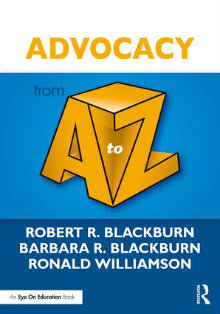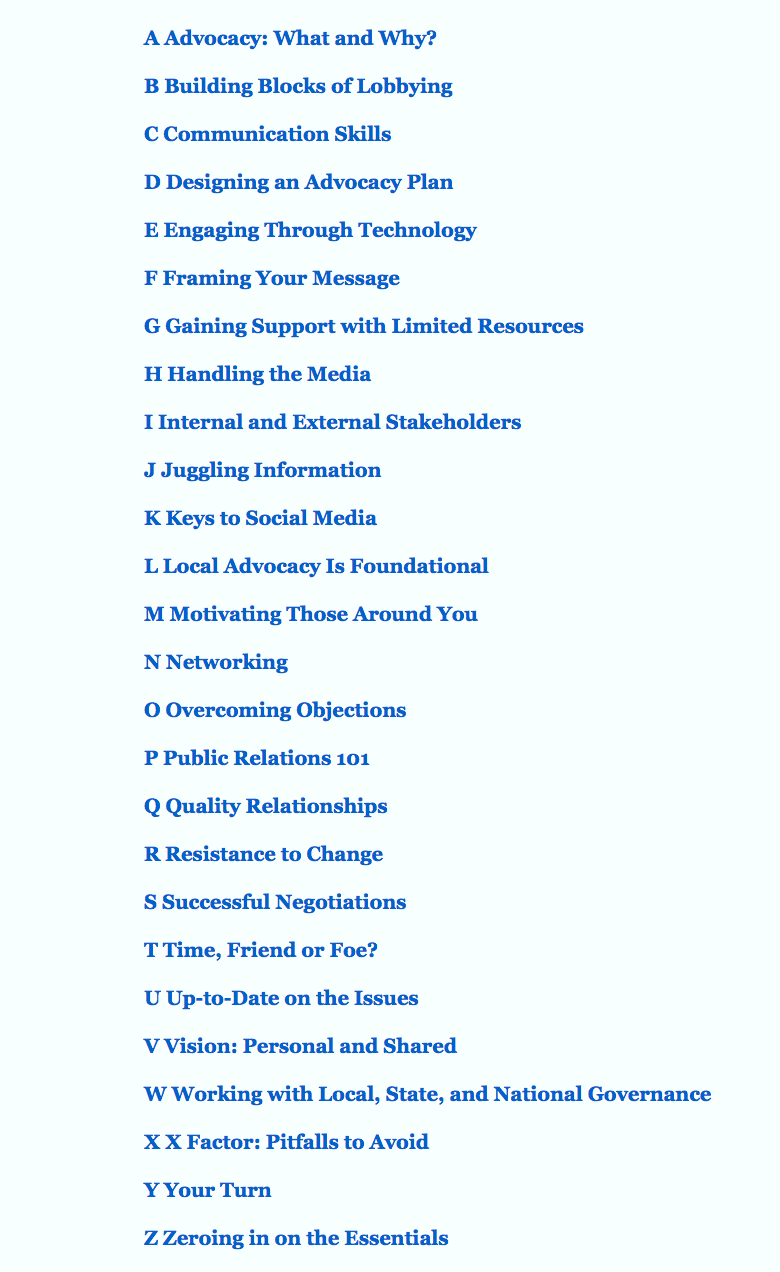A to Z Advocacy Advice for School Leaders
Advocacy from A to Z
By Robert Blackburn, Barbara R. Blackburn and Ronald Williamson
(Routledge/Eye On Education, 2018 – Learn more)
Reviewed by Mary Langer Thompson

Advocacy A to Z includes 26 topics, organized alphabetically. Inspirational quotes begin each chapter and reflection questions close each chapter.

In “Building Blocks of Lobbying,” the book goes on to describe the differences between advocacy and lobbying, explaining that “Lobbying always involves advocacy, but advocacy does not always involve lobbying.” The differences between the two are shown in a chart. I learned that a tax-exempt, 501c(3) organization can lobby, but not too much. The focus has to remain on educating people about policy issues. Learn the seven characteristics of an effective lobbyist, such as knowing your elected officials and 15 ways to keep in touch with them.
The “C” chapter is for “Communication Skills.” Learn the 10 principles of effective communication, including telling a story and being empathetic with your audience. Read tips for interacting with your school board. “D” stands for “Designing an Advocacy Plan,” and gets somewhat more specific. The experienced administrator may find tips and advice to be common sense, so I was glad to see the “Sample Advocacy Plan” in this chapter. (Readers can download this and other resources at the Routledge site.)
“E” stands for “Engaging Through Technology” and talks about the three criteria for a good blog. Framing your message is the topic of the next chapter which uses the inverted pyramid and elements of an elevator talk. “G” is a chapter on “Gaining Support,” especially when one has limited resources. Business and community partnerships and grants may be helpful.
A most important chapter is “Handling the Media.” The authors discuss changes in our media environments, including the sharp decline in print editions of daily newspapers. Included are useful tips for talking to the media. Although the authors advise not to use jargon, perhaps some lists of words to be careful of or to carefully define and words of comfort during a crisis would help, too.
The “J” chapter on “Juggling Information” and the “T” chapter on time management are authored by Dr. Frank Buck (see the MiddleWeb review of Get Organized! Time Management for School Leaders). Buck discusses how to use a digital task list, how to classify all files into three categories and then to create a parallel system for digital documents. He mentions specific organizational software. I liked the specificity and practical focus of these chapters. There’s a great suggestion to look at your list and identify the “Fab Five.” What five things would you want to accomplish if you could accomplish only five tasks today?
“K” talks about “Keys to Social Media.” Facebook, Twitter, YouTube, Flickr and ways to use them are discussed. “L” stands for “Local Advocacy,” which the authors believe is foundational, quoting Tip O’Neil, “All politics is local.” “M” stands for motivating others and provides a chart for what high and low motivation looks like. “N” stands for “Networking,” and covers advantages and disadvantages of working in coalitions.
What if you run into opposition? “O” deals with “Overcoming Objections,” and mentions common ones, my favorite being “We are already doing too much. Now you want to add something else?” What can objection look like? There is “Death by Delay,” “Confusion,” and “Character assassination.” Some real examples instead of general tips to overcome objections would be more helpful here.
“P” stands for “Public Relations” and provides steps for developing a Media Plan. In the chapter “Q,” for “Quality Relationships,” leaders will find most useful the example of one principal who identified the “champions,” “allies,” “fence-sitters,” “mellow opponents,” and “hard core opponents” on her staff and designed a plan for each person. “S” stands for “Successful Negotiations,” and stages of negotiating are provided, a longer and shorter version, with sample dialogue. Read the “Top Ten Effective Negotiation Skills.”
“U” means being Up-to-Date on issues. Read what Gary Marx of Educational Research Service says are four shifts that are changing schools, including leaders needing to collaborate. There are seven ways to respond to these shifts, including challenging our own assumptions. “V” for Vision tells why we need a personal vision for advocacy. I like the idea of “Vision Letters,” and there is even a sample one. Another tool is the “Hot Air Balloon Vision Activity.”
The best use of this book would be for beginning administration college classes, as a textbook. The general tips, bullets, and lists are not as interesting and informative as the sample plans, vision letters, and practical tips, which I prefer come in the beginning of the book for motivation, but which the contrived A-Z organization prohibits. The main value is in encouraging readers to be pro-active advocates for education.



































